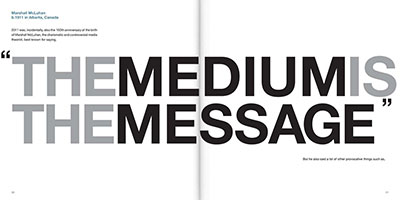Publishing to sharing information

Publishing the same message in different mediums affects its meaning. Marshall McLuhan believed that the medium used to deliver the message has a substantial outcome on how the content is received and processed. Therefore, the audience will respond differently to the message depending on the medium's space in which it is published. With the ever-expanding mediums, available to us through our rapidly evolving computer technologies, it has become even more imperative for those wanting to publish their message to ensure they craft it for the platform. Writing for the medium in which they chose can have the most effective outcome. It is also imperative that we continue to acquire the skills to use new technologies to keep best attuned with newly emerging mediums.
Prior to computer technology advancements, there were only a handful of different mediums to choose from to publish written work through. Since the publishing process was so physically time-consuming and there were constraints with adding graphics and styling, less emphasis was on the visuals and more on the written words themselves. Broadly speaking, more time was required to be able to create even the simplest forms of written work. If there were written errors on a page, they either stayed that way until the next printing or someone had to retype and recreate the page from scratch. An excellent example of this is when McLuhan and Fiore got their book back from the typesetter, there had been a typo in the name of the book. Instead of the word “Message,” the typesetter had put “Massage.” However, McLuhan liked the mistake and said “Leave it alone! It is great, and right on target!”

With the advent of computer technology and desktop publishing, came new forms of mediums. Desktop publishing tools gave individuals the power to be able to create and deliver their messages in these new medium channels. Layouts of written work could easily have graphic elements, photos, or illustrations added to them, with the ability to instantly see them the way they would be when printed. This WYSIWYG (what you see is what you get) capability made it possible to enhance written work with more color, graphics and font options, thereby altering the emphasis to be more on the visual appearance of content, rather than the written work itself. The message was changed. We started judging the book by its cover as well as the way the content inside was presented.
 Writing is such a large part of how we communicate with others, and in the previous period, it was more of a one-sided conversation than a well-rounded dialog. Now, by using computer technologies like the internet and web technologies, we can share our message and allow others to respond, share our message with others, and reiterate it for other uses. Like author Lev Manovich, “a new media object is not something fixed once and for all, but something that exists in different, potentially infinite versions”. This is where modern publishing technologies are today. The message is being delivered from the computer, through the internet, in many different forms.
Writing is such a large part of how we communicate with others, and in the previous period, it was more of a one-sided conversation than a well-rounded dialog. Now, by using computer technologies like the internet and web technologies, we can share our message and allow others to respond, share our message with others, and reiterate it for other uses. Like author Lev Manovich, “a new media object is not something fixed once and for all, but something that exists in different, potentially infinite versions”. This is where modern publishing technologies are today. The message is being delivered from the computer, through the internet, in many different forms.
Today and in most cases, written work may not even be printed anymore, for it to be published. Instead, it stays in a digital, easily changeable form. Content, especially graphics and fonts are almost effortlessly obtained and can be instantly accessed, making it easy to enhance written work to new levels, therefore, changing its message. The new channels of self-publishing have changed the way we think of the content it presents. From blogging to Twitter, and other social media website, content must not only fit the structures required for them, but it is expected to be produced and published at a quicker rate than ever before. The rapid release of information brings new constraints and issues to solve as we move forward, to keep the intended message whole as well as reliable as it moves through different forms of mediums.
